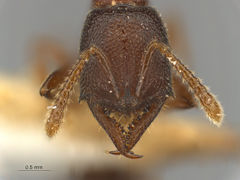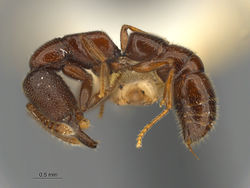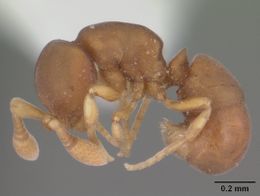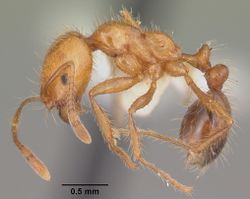Key to Hispaniola Subfamilies
Additional information about the ants of the island can be found here: Ants of Hispaniola
1
- A single reduced or isolated segment (petiole) between the mesosoma and gaster . . . . . 2
- Body with two reduced to isolated segments (petiole and postpetiole) between the mesosoma and gaster . . . . . 8
2
return to couplet #1
- sting absent . . . . . 3
- sting present and often projecting out of the gaster in most specimens . . . . . 4
3
return to couplet #2
- In dorsal view, apex of gaster with a semicircular to circular orifice (acidopore) that may be fringed with hairs . . . . . Key to Hispaniola Genera of Formicinae
- In dorsal view, apex of gaster ending in a slit like opening, lacking an acidopore . . . . . Key to Hispaniola Genera of Dolichoderinae
4
return to couplet #4
- In full face view anterior clypeal margin with peglike denticles that are similar in size to denticles on the inner margin of mandibles AND the petiole is broadly joined to the gaster . . . . . Amblyoponinae; a single species, Fulakora falcata, is present
- In full face view anterior clypeal margin not bearing any denticles. Petiole may or may not be broadly joined to the gaster . . . . . 5
5
return to couplet #4
- In dorsal view, all of the following: large blocky petiole AND maximum width of first gastral segment greater than maximum width of petiole AND first gastral segment with a posterior constriction in the form of a smooth band-like segment that fully separates the wider anterior portion of the segment from the remainder of the gaster, the width of this band is less than the width of the anterior unbanded portion of the first gastral segment and the attached posterior gastral segment . . . . . Key to Hispaniola Genera of Dorylinae
- Petiole and gaster not as above . . . . . 6
6
return to couplet #5
- With both of the following: second gastral tergite much longer than length of first gastral tergite and all posterior gastral tergites AND gastral tergites posterior to 2nd gastral tergite appear to arise ventrally from 2nd gastral segment and remaining portion of the gaster reflected anteriorly . . . . . Key to Hispaniola Genera of Proceratiinae
- Second gastral tergite may or may not be longer than first gastral tergite; terminal end of gaster arises from posterior portion of gaster and terminal end either oriented posteriorly or projected downward (but not anteriorly) . . . . . 7
7
return to couplet #6
- In dorsal view, prominent parallel stria across at least the mesosoma (Gnamptogenys haytiana may not have stria present on the pronotum but stria are present across the dorsum of the mesonotum and propodeum) but may also be present on head and gaster, stria have varying orientation: in some species mostly longitudinal while in others the orientation varies from one sclerite to the next . . . . . Ectatomminae: one genus is present - Key to Hispaniola Gnamptogenys
- In dorsal view prominent parallel stria are not present . . . . . Key to Hispaniola Genera of Ponerinae
8
return to couplet #1
- In full face view, eye length along the margins of the head extending across more than half of the lateral margin . . . . . Pseudomyrmecinae: one genus is present - Key to Hispaniola Pseudomyrmex
- Eye length along margin of head never approaching covering more than half of the lateral margin of the head . . . . . Key to Hispaniola Genera of Myrmicinae

















